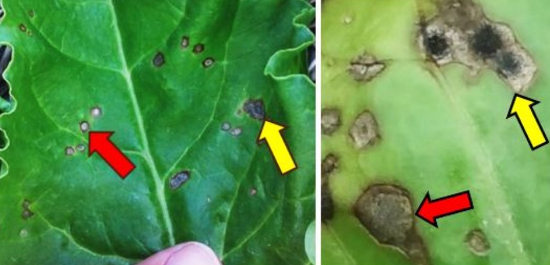By Daniel Bublitz
Cercospora and Alternaria leaf spot were detected in the Michigan sugarbeet production region. Lesions were found at the Saginaw Valley Research and Extension Center on June 17, 2019 and in a local commercial field on June 18, 2019. Severity was generally low in these fields, however, high pressure areas of early (April) planted fields may be at risk of increased infection.
Cercospora leaf spot is caused by Cercospora beticola, a fungus that is favored by warmer temperatures (75-95 degrees Fahrenheit) and high humidity. Alternaria leaf spot is caused by various Alternaria spp., which are fungi that are favored by relatively cool temperatures and high humidity. Despite cooler air temperatures in Michigan this season, high humidity conditions have been conducive for the development of both diseases, as confirmed by these first spot reports.

(Left) Cercospora (red arrow) and Alternaria leaf spot (yellow arrow) on sugarbeet in Tuscola County. (Right) Enlarged image showing the difference in appearance of the two leaf spots when producing spores. Cercospora beticola produces silver, needlelike spores, which give the lesion a silver cast when present. Alternaria spp. produce black chains of spores, which give the lesion a velvety black appearance when present. Photo by Daniel Bublitz.
Detecting a Cercospora leaf spot lesion this time of the year is not unexpected, as the first lesion in the growing area last year was detected on June 15. However, you should begin actively scouting fields for the disease. Also, consider applying a protectant fungicide if you have an early planted field, if you have a susceptible variety or if your field is located adjacent to an inoculum source, such as a field that was planted to sugarbeets last year.
Source:msu.edu